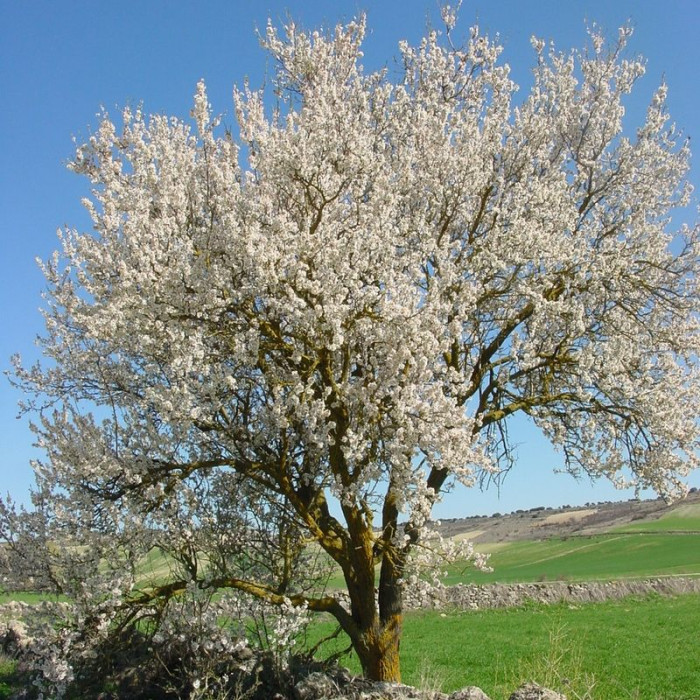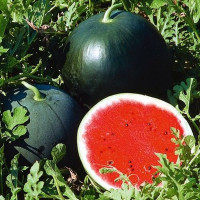Almond / Prunus dulcis, Prunus amygdalus or Amygdalus communis - is a small tree, of medium vigor, 3,5 - 4 meters tall at 8 years of age. The crown is compact, rounded, skeletal branches extend at a relatively obtuse angle. Almonds are often classified as nuts, although they are actually stone fruits. Almonds are similar in size and shape to apricot kernels.
It begins to bear fruit in the third or fourth years. Differs in late flowering, but early ripening of fruits. The weight of the nuts is 2,5 - 3,5 grams, the shell is thin but relatively strong, the kernel content is 56%, the number of nuts with double kernels does not exceed 5%. When the kernel humidity is no more than 15%, the shell is stored for over 3-5 years under normal room conditions. Productivity at 8 years of age is 5,8 kg of dry nuts per tree.
Among the ancestors of modern Tajiks and Uzbeks - the Sogdians - almonds are a sacred tree. They prayed, holding in their hands not candles, but branches of blossoming almonds. They were placed on altars, placed next to a sick child - from evil spirits. Among the Greeks, almonds were also a sacred plant, considered a symbol of fertility.
The word "almond" is borrowed from medieval Greek ("amygdalos"). But this is also a borrowing from the Greeks - the Hebrew “magidyel”, which means “precious gift of God.” This is a beautiful picturesque tree, especially when it is in bloom.
Almonds have two types of shoots: elongated vegetative ones and shortened generative ones. Leaves are lanceolate. The flowers are solitary, up to 2,5 cm in diameter, with white or light pink petals, numerous stamens and one pistil, consisting of a goblet-shaped calyx and a pink or red corolla. The fruit is a dry, velvety-pubescent oval single drupe; the dry pericarp is easily separated from the stone when ripe. The seeds (“nuts”) are the same shape as the fruits themselves, covered with small dimples, sometimes with grooves, 2,5 - 3,5 cm long, weighing from 1 to 5 grams.
Almonds are sensitive to moisture and therefore are not grown in humid climates. Almonds grow on all types of soil, including limestone and thin soils, also grow on rocky and gravelly slopes at altitudes up to 1600 m above sea level, preferring soils rich in calcium. Very light-loving, very drought-resistant thanks to a well-developed root system and economical transpiration.
It blooms in March-April, the fruits ripen in July-August. It begins to bear fruit at the age of 4-5 and fruiting continues for 30-50 years, lives up to 130 years. Propagated by seeds, root suckers and stump shoots. Tolerates frosts down to -25 °C, but with the beginning of the growing season it suffers from spring frosts.
Valuable early spring honey plant, produces nectar and a lot of pollen. Used as a drought-resistant rootstock for peaches and apricots. Almonds can be planted as an ornamental soil-protective plant.
The kernels of cultivated sweet almonds contain fatty oil (up to 40-60%), protein substances (about 30%), mucus, vitamins, coloring matter - carotene, carotenoids, lycopene, etc., as well as essential oil (0,5-0,8%), which determines their smell, and traces of amygdalin glycoside.
The fatty oil contains glycerides of oleic (80%) and linoleic (15%) acids. Oil obtained from the unshelled seeds of sweet almonds contains small amounts of linolenic and myristic acids, which are absent in oil obtained from the shelled seeds. Whole almond kernels have no odor. When sliced, they acquire a specific almond flavor.
Almonds are popular for their dietary properties: low in saturated fat, high in vitamin E, and high in unsaturated fatty acids. Oil is obtained from almond seeds by cold or hot pressing. Almond oil is used in the food, perfume, and pharmaceutical industries. It serves as a camphor solvent for injection, the basis for medicinal and cosmetic ointments (softens the skin and has an anti-inflammatory effect), it is prescribed orally, especially for children, as a laxative, and in the form of emulsions - as an enveloping and emollient.
Sweet almond kernels were used in folk medicine for anemia, diabetes, bronchial asthma, insomnia, migraines, as an antitussive, for convulsions; almond oil was used internally as a sedative for heart disease, as an anti-inflammatory for pneumonia and throat diseases, for flatulence, as a means of increasing appetite; externally - from bedsores. Used for digestive disorders and impaired renal function.
One of the planting methods is to sow seeds in the fall at the end of September to a depth of 10 cm. After the ground freezes to a depth of 5 cm, the ridge must be covered with a thin layer of straw manure. In the spring, the shelter is removed, and shoots should appear in early June. When side shoots appear from the axils of the lower leaves of the seedlings, their tops must be carefully pinched, and when they begin to branch, remove them to raise the crown of the tree. By early to mid-September, the resulting trees, approximately the size of a little finger, must be budded with peaches, apricots or plums.
Tree care - standard pruning in a vase shape for better penetration of light and solar radiation. There is no need to thin out flowers. All flowers reach fruit set stage and most fruits are harvested. Weeds along the rows should be treated with herbicides, and between the rows should be mowed. As an alternative, it is possible to grow a cover crop in this area, mainly legumes.

No questions about this product, be the first and ask your question.























